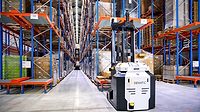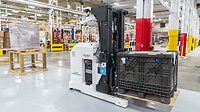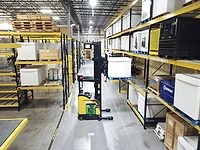Warehouse
Automated guided vehicles address labor, safety issues
AGVs work to support safety in facilities

Image courtesy of Getty images
In the 2001 animated comedy film “Monsters, Inc.,” the city of Monstropolis harnesses the screams of human children for energy. At the Monsters Inc. factory, skilled monsters employed as “scarers” venture into the human world to scare children and harvest their screams through doors that activate portals to children’s bedroom closets. While the work is considered dangerous, as human children are believed to be toxic and capable of harming monsters, energy production is declining because children are becoming less easily scared, and the corporation’s CEO, Henry J. Waternoose III, is determined to prevent the company’s collapse.
Although monsters are uninvolved, in the real world of beverage operations, today’s labor shortage is leading more warehouses to embrace automation to boost productivity. As automated guided vehicles (AGVs) are one type of technology to help overcome labor shortages in the warehouse, experts note that this technology provides operators a means to fill the resource gap, allowing human labor to be allocated to more complex tasks.
Mariah Holcomb, warehouse management software product manager at Encompass Technologies, Fort Collins, Colo., points to the need for the most labor-intensive and repetitive processes in the warehouse to be automated.
“Because human knowledge and ability is a valuable and finite resource, that needs to be allocated to more nuanced, operational work,” she says. “Smaller teams also means there’s a need to reorganize responsibilities and re-evaluate what tools are helping get the job done efficiently.
“With few potential employees that have experience with heavy machinery, it’s also important to try to lower safety risks as much as possible," she continues.
Kyle Nevenhoven, principal consultant at Atlanta-based Dematic, echoes similar sentiments, noting that labor shortages in beverage warehousing and distribution are forcing organizations to evaluate all aspects of their operations.
“Moving the majority of picking operations to first-shift, consolidating to a four-day work week, offering more flexibility in shifts and hours, and introducing automation are common considerations in reducing the impact of labor shortages,” Nevenhoven says. “Solutions such as AGVs are well suited to perform redundant and repeatable tasks, such as moving product across a facility, storing and retrieving product, replenishing pick locations, and loading trailers.
“With the automation of these tasks, organizations can focus their labor on other tasks that have a greater impact on the overall performance of the business or those that are more desirable and rewarding for employees,” he continues. “Ultimately, these considerations are all focused on the organization becoming the employer of choice to increase their ability to recruit and retain employees.”
Protecting operations
As labor shortages continue to impact beverage warehousing in multiple ways, experts note that it is becoming increasingly difficult for warehouse teams to meet operational demands.
Meanwhile, the cost of labor is increasing while turnover also is increasing, says Brian Spradlin, president of Houston-based MCJ Supply Chain Solutions, a subsidiary of Jungheinrich and Mitsubishi Logisnext Americas.
“Increased costs, increased training demands, late and missed deliveries, inaccurate order picks are just a few of the symptoms of this underlying issue,” he explains. “By providing consistent, reliable throughput in processes, which can be automated, precious human labor can be allocated to more complex tasks.”
Encompass’ Holcomb highlights how automated solutions such as AVGs help address the various challenges that warehouse teams face.
“The beauty of automation is that daily standard practices can fairly easily be translated to a machine that focuses solely on one standard process,” she says. “Not only can this help guard against gaps in the workforce, but this can also help protect team members by allowing AGVs to handle the most grueling work in the warehouse.
“These kinds of machines can help keep team members focused to smaller zones for greater efficiency, and reduce training time needed to start being productive,” Holcomb continues.
Aside from allocating laborious tasks, MCJ’s Spradlin points to AVGs role in operational safety.
“Another big benefit for operations is safety ― AGVs are predictable and safe, and they don’t suffer from fatigue or illness,” he says. “AGVs can also benefit beverage operations by operating in refrigerated environments.”
Dematic’s Nevenhoven echoes similar sentiments, noting that AVGs work to increase the safety of an entire facility.
“The use of AGVs can increase the safety of a facility by the controlled and orchestrated movement of equipment and product through the warehouse where human error and inexperienced operators are typical causes of injuries, property damage and product damage,” he explains.
Technology for the future
As AGV technology has matured over the years in both navigational technology and AGV types, experts highlight how advanced solutions are helping streamline warehouse operations.
“Early navigation technology consisted of in-floor wire guidance, magnets and other fixed technologies. Modern AGVs use a combination of laser guidance as well as advanced vision systems to provide accurate navigation with limited infrastructure requirements,” Dematic’s Nevenhoven explains. “Significant advancement in software, as well as advancements in sensor technology, has enhanced the variety of tasks AGVs can perform, going from simple transportation of pallets to the ability to interface with pallet racking, perform floor stacking of pallets, and automatically loading trailers.
“Additionally, the movement from dedicated and purpose built AGVs to the automation of manual fork truck designs has increased the types of AGVs offered to the market, and introduced a level of redundancy where an automated fork truck can be used in a manual mode of operation if required,” he continues.
MCJ’s Spradlin points to the advancements in software and sensors.
“Software systems have become more advanced in their ability to process algorithms, which bridge machine movements with WMS requests,” he says. “Sensors have become more accurate and reliable allowing AGV manufacturers the ability to develop machines, which can better navigate their environments and improve safety in operations.”
Further, as technology becomes smarter with increased capabilities and autonomy, AVGs “will be able to perform more processes dock to dock, from unloading and loading trailers, to autonomously managing tasks and navigating tighter, more restrictive spaces,” Spradlin says. “AGVs will also work more seamlessly with other machines and human operators.”
For beverage warehousing and distribution looking to invest in AVGs, Dematic’s Nevenhoven points to how implementation can be incorporated into existing manual operations.
“AGVs allow for the implementation of flexible automation, which is often able to be incorporated into existing manual operations with minimal changes to layout and with minimal infrastructure,” he says. “This provides an entry point into automation for beverage distributors, helping to reduce the impact of labor shortages.
“Typical ROI for AGVs ranges from 18 months to three years, however, this is highly variable based upon hours of operation, the types of tasks being automated, and a variety of additional factors,” he continues.
Encompass’ Holcomb reiterates the important role AGVs play in filling the labor gap today, and in the future.
“AGVs are a great way to supplement human operations and provide teams with new ways to be more successful,” Holcomb says. “We’re not talking about robots replacing people here — we’re talking about making jobs easier, safer, and having a lower barrier of entry to true operational success.”
Looking for a reprint of this article?
From high-res PDFs to custom plaques, order your copy today!







